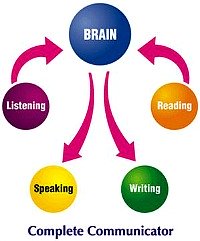 |
Learn English Locally, Apply It Worldwide! Enjoy Regular Practice |
Pieces of Information
In this lesson we shall start looking into the pieces of information that go into the message you want to put across, whether in writing or by speaking. These meaningful pieces of information are the ones that influence the rising and falling tones and the overall intonation in your verbal communication.
You know how beginners speak English in one monotone line of words that puts the listener to sleep at any given moment? Well, the problem here is that the speaker doesn't know how to divide the message into meaningful pieces and give them the adequate intonation, according to the intended message and the amount of emotion (s)he intends to put into that message.
These pieces of information can be defined as the pieces of language which are separated from what goes before and from what follows and which do not contain any punctuation marks. In written English, we use the punctuation marks to make this separation, but not to split the unit/piece of information.
In spoken English, a piece of information can be defined as a tone unit or a unit of intonation containing a nucleus.
A nucleus is the focal point of an intonation pattern, like the word that is stressed in a sentence. We may describe a nucleus as a strongly stressed syllable which marks a major change of pitch direction, either up or down, which is indicated by an arrow. Take for example, the sentence:
“She is going to the States.”
Have a look at the change of pitch indicated by the arrow.
 |
In this example, the nucleus marks a fall in pitch towards the end of the sentence, which we can simply indicate by underlining and without indicating the other stressed syllables. |
“She is going to the States. ”
We also indicate the boundaries of a tone unit by using the symbol ¦:
¦“She is going to the States. ”¦
Now, notice the difference between these sentences:
“My friend has a cat and two rabbits.” [1]
“My friend has a cat; she also has two rabbits.” [2]
They practically mean the same, but [1] presents the message as ONE piece of information, whereas [2] presents it as TWO pieces of information, separated by a punctuation mark (;).
In speech, the same contrast can be seen in:
¦“My friend has a cat and two rabbits. ” ¦[1a]
¦“My friend has a cat¦; ¦she also has two rabbits. ” ¦[2a]
I suggest you should practice determining the tone units in the books and articles you read, before we step further next time, to work on dividing a message into tone units. This type of exercise will be very useful in speech - it will help you to work your intonation around these tone units, so that the listener will understand the meaning of your message better.
English Corner Weekly E-zine
Packed with knowledge, published on Tuesdays.
Get yours here!
Our Archives:
Our lessons in the names and sounds of letters, short & long vowel sounds, CVCs, CCVCs, CVCCs, sight words, vowel and consonant contrasts, etc.
Our lessons will help increase your vocabulary, word recognition, find meaning in context, skills for TOEFL tests and other games, for fun.
Here we shall build some lessons to help you improve your writing skills.
Lots of lessons: cause & effect, comparisons, linking signals, relative clauses, presenting information, expressing emotions and grammar games, of course. We had more lessons on: intensifying adverbs and phrasal verbs, expressing various concepts such as addition, exception, restriction and ambiguity. Lately we started some exercises: likes/dislikes, frequency adverbs (twice), verb tenses, etc.
Learn how to build a website, by using the SBI! system - start from the basics, developing a site concept and a niche, supply and demand, learn about profitability and monetization, payment processing, register domain, website structure and content as a pyramid. Also learn about the tools I'm using to build this website. We also covered how to build traffic, working with search engines, building a good system of inbound links, using social marketing and blogs with the SBI system, how to use Socialize It and Form Build It, how to publish an e-zine and how to build a social network in your niche.
We looked at a few games by now: Countable & uncountable nouns, Free Rice, Name That Thing, Spell It, Spelloween, the Phrasal Verbs Game, Preposition Desert, The Sentence Game, Word Confusion, Word Wangling, Buzzing Bees, and The Verb Viper Game.
Be prepared to play and learn more pretty soon.
